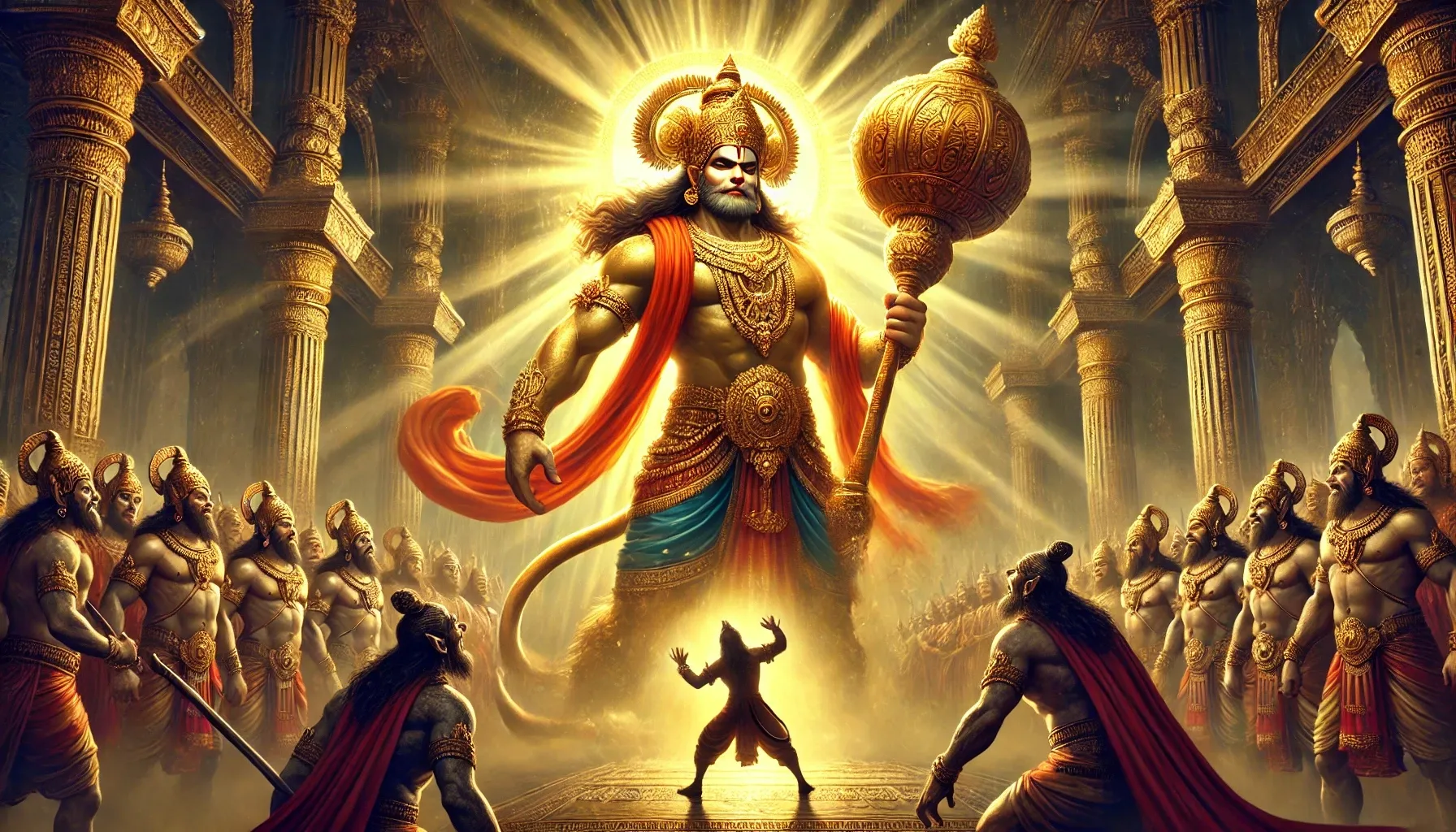The Ramayan, one of the greatest epics of Hindu scriptures, serves as an eternal guide to leading a life of virtue, devotion, and righteousness. It is a scripture rich with profound wisdom and moral values that remain relevant in today’s world. The stories from this sacred text offer deep insights into the human condition and how faith and devotion can lead to victory over evil. By exploring the lives of the characters in the Ramayan, we can extract invaluable lessons that can inspire and transform our own lives. Here, we delve into three powerful stories that highlight the importance of faith, sacrifice, and devotion, imparting lessons that remain timeless.
1. Angad’s Unshakable Faith: The Power of Fearlessness

One of the most compelling episodes in the Ramayan is the story of Angad, the son of the mighty Vanara king Bali. Angad was sent by Lord Ram as a messenger to Ravan, the demon king of Lanka, to negotiate peace and urge him to return Sita before the great war commenced.
As Angad entered Lanka, he was greeted with suspicion and fear. Many demons mistook him for Hanuman, who had previously stormed through the city, setting it ablaze. Unfazed by the intimidating atmosphere, Angad walked into Ravan’s court with confidence, knowing that he was on a divine mission and under the protection of Lord Ram.
Standing before Ravan, Angad boldly conveyed Ram’s message. He reminded the demon king of the past, recounting how his own father, Bali, had once overpowered Ravan and kept him subdued under his armpit for six months. Angad warned Ravan that if he did not surrender, he too would face a similar fate.
Enraged, Ravan mocked Ram’s greatness, questioning why such a powerful being had been exiled to the forest. Angad, unable to tolerate the insult, struck the ground with his fist, causing the entire court to tremble. In that moment, Ravan’s crowns fell to the ground, a symbolic indication of his impending downfall.
To further prove his strength and unwavering faith in Ram, Angad planted his foot firmly on the ground and challenged anyone in Ravan’s court to move it. Despite several attempts, none of Ravan’s warriors could budge his foot. Finally, Angad taunted Ravan himself, saying, “Why send others? Come, try to move my foot yourself.” When Ravan bent down to grasp Angad’s foot, Angad swiftly reminded him, “If you must touch someone’s feet, let it be Ram’s, for only he can grant you salvation.”
Lessons from Angad’s Story
This tale imparts a powerful lesson about faith and fearlessness. Angad’s strength did not come from physical prowess alone, but from his unwavering belief in Lord Ram. His courage in the face of adversity teaches us that when we have faith in a higher power, we become unshakable. If our trust is placed in material wealth, status, or power, we will always live in fear of losing them. However, if our faith is rooted in righteousness and devotion, we become fearless and indomitable.
2. Kaikeyi’s Misunderstood Sacrifice: The Ultimate Act of Love

Kaikeyi is often misunderstood as the antagonist in the Ramayan, primarily because she was responsible for Ram’s exile. However, a deeper examination of her actions reveals an unparalleled sacrifice, an act of selfless love that played a crucial role in fulfilling Ram’s divine mission. Kaikeyi’s story is not one of malice but of unwavering devotion and an immense burden she carried for the greater good.
Kaikeyi’s Love for Ram
Kaikeyi was not just one of King Dasharath’s queens; she was also a fierce warrior and the most beloved of his consorts. She had once accompanied him to the battlefield and saved his life, an act that earned her two boons from the grateful king. These boons would later be instrumental in Ram’s exile.
From Ram’s childhood, Kaikeyi adored him like her own son. She was deeply affectionate and protective of him. Unlike the conventional perception that she was jealous or insecure, she, in fact, had the highest regard for Ram’s virtues and was immensely proud of him.
The Divine Conversation Between Ram and Kaikeyi

According to lesser-known accounts, Ram once had a private conversation with Kaikeyi, where he revealed to her his divine mission. He explained that his purpose was not only to rule Ayodhya but also to liberate countless sages, defeat demons, and uphold dharma. However, for this to happen, he needed to leave the kingdom and spend fourteen years in exile. The challenge was to create a situation where this exile would be inevitable and unquestionable.
Kaikeyi, being a mother figure to Ram, was devastated. She knew that this meant sacrificing her own dignity, bearing the hatred of the people, and even being vilified in history. However, her devotion to Ram was far greater than her desire for personal honor. She agreed to play her part, despite the pain it would bring her.
The Orchestration of Ram’s Exile
On the eve of Ram’s coronation, Kaikeyi’s heart must have been heavy, knowing she was about to commit an act that would make her appear heartless. Guided by Ram’s earlier request, she activated the two boons granted to her by Dasharath. The first boon demanded Ram’s exile for fourteen years, while the second insisted that her son, Bharat, be crowned as the king in his place.
The reaction was immediate and devastating. King Dasharath was heartbroken and unable to cope with the thought of separating from his beloved son. The people of Ayodhya cursed Kaikeyi, seeing her as the root of all misfortune. Even Bharat, upon learning of his mother’s actions, condemned her and refused to accept the throne.
Kaikeyi’s Silent Suffering

Despite the anger and disdain directed at her, Kaikeyi never defended herself. She bore the weight of being labeled cruel and selfish because she knew that the ultimate goal was far greater than any personal suffering. She had agreed to this role not for personal gain but to facilitate Ram’s mission, ensuring that he could fulfill his divine duty.
Her suffering was twofold—not only did she lose the love and respect of her family and the people, but she also had to witness the grief of Dasharath, who eventually passed away unable to bear the pain of Ram’s departure. Yet, Kaikeyi did not waver. She stood firm, silently enduring the pain, knowing that history would never recognize her sacrifice.
Bharat’s Reaction and Kaikeyi’s Redemption
When Bharat learned of his mother’s actions, he was furious. He rushed to Chitrakoot, where Ram was staying, and implored him to return to Ayodhya. However, Ram, being steadfast in his dharma, refused to go back before completing the fourteen years of exile.
Bharat then renounced the throne, placing Ram’s wooden sandals on it as a symbol of rightful rule. Kaikeyi, realizing the depth of her son’s commitment to Ram, was overwhelmed with both guilt and pride. She understood that her sacrifice had set forth a chain of events that strengthened the love and unity between Ram and Bharat, ultimately reinforcing the values of dharma and devotion.
Kaikeyi’s Legacy and the True Meaning of Love
Despite playing such a crucial role in Ram’s mission, Kaikeyi remains one of the most misunderstood characters in the Ramayan. Her love was not possessive or self-serving; it was a love that embraced suffering for the sake of a greater cause. She sacrificed her own happiness, her reputation, and even the affection of those she cherished most—all for the fulfillment of Ram’s divine duty.
Her story serves as a profound lesson on selfless love and sacrifice. Love is not merely about attachment or seeking joy; it is also about the willingness to endure hardship for the well-being of a loved one. Kaikeyi’s sacrifice teaches us that sometimes, the toughest decisions and the most painful paths are necessary to achieve a higher purpose.
Lessons from Kaikeyi’s Story
- True love is selfless. Kaikeyi’s love for Ram was so profound that she was willing to be despised for his divine mission to unfold.
- Sacrifice often goes unrecognized. Many great acts of sacrifice are misunderstood and unappreciated in the short term, but their impact is immeasurable in the long run.
- Dharma requires difficult choices. The path of righteousness is often filled with painful decisions, but those who uphold dharma ultimately achieve spiritual victory.
- History is not always kind to the selfless. Kaikeyi bore the brunt of judgment and blame, but her role was essential in shaping the future course of Ram’s life and mission.
Kaikeyi’s misunderstood sacrifice stands as a testament to the highest form of love—one that transcends personal desires and endures suffering for the greater good. Her story, when viewed with wisdom, reminds us of the unseen sacrifices that often shape destiny.
3. Hanuman’s Innocent Devotion: Love Beyond Rituals

Among the many episodes in the Ramayan, one of the most touching is the story of Hanuman’s innocent and boundless devotion to Lord Ram.
One day, as Sita was applying sindoor (vermilion) on her forehead, Hanuman curiously asked her the reason behind this ritual. Sita, in a gentle and loving manner, explained, “By applying sindoor, I ensure the long life and well-being of my Lord Ram.”
Hanuman, taking her words to heart, decided that if a small amount of sindoor could please Ram, then covering himself entirely in it would bring his Lord immense happiness. Without hesitation, he smeared sindoor all over his body and presented himself before Ram, covered in red.

Seeing Hanuman’s amusing yet heartwarming gesture, Ram was deeply moved. Touched by his devotee’s pure and innocent love, Ram declared that Hanuman’s devotion was unparalleled. Since that day, devotees have honored Hanuman by offering sindoor to his idols, a tradition that continues in temples worldwide.
Lessons from Hanuman’s Story
Hanuman’s devotion teaches us that true love and faith transcend rituals. Devotion is not about elaborate ceremonies or rigid customs; it is about the purity of one’s heart. His innocent and selfless love for Ram is a lesson in sincerity, demonstrating that the essence of devotion lies in intention rather than external practice.
Conclusion: Embracing the Timeless Lessons of the Ramayan
The Ramayan is more than just an ancient epic; it is a beacon of wisdom, guiding us through life’s challenges. The stories of Angad, Kaikeyi, and Hanuman offer profound teachings:
- Angad’s story teaches us to be fearless and steadfast in our faith.
- Kaikeyi’s sacrifice highlights the true essence of selfless love.
- Hanuman’s devotion reminds us that sincerity and purity of heart matter more than rituals.
By incorporating these lessons into our daily lives, we can cultivate inner strength, selfless love, and unwavering devotion. The Ramayan continues to inspire and transform those who seek its wisdom, offering guidance on leading a life filled with faith, purpose, and righteousness.
Resources
Specific Video
FAQs
1. What is the significance of faith in the Ramayan?
The Ramayan emphasizes faith as a guiding force in overcoming obstacles. Angad’s unwavering belief in Lord Ram showcases how faith can make one fearless and steadfast in righteousness.
2. Why is Kaikeyi often misunderstood in the Ramayan?
Kaikeyi is seen as an antagonist, but her actions were driven by a higher purpose. She sacrificed her reputation and endured hatred to fulfill Ram’s divine mission, demonstrating selfless love and duty.
3. What does Hanuman’s sindoor story teach us about devotion?
Hanuman’s act of covering himself in sindoor symbolizes pure and unconditional devotion. His love for Lord Ram was beyond rituals, teaching us that true devotion comes from sincerity and selflessness.
4. How do the lessons of the Ramayan remain relevant today?
The Ramayan teaches values like faith, sacrifice, and devotion, which are timeless. Its stories inspire resilience, righteousness, and love, guiding individuals through life’s challenges.
5. What can we learn from Angad’s encounter with Ravan?
Angad’s fearlessness in Ravan’s court teaches the power of courage and conviction. It reminds us that when we stand for truth and righteousness, no force can shake our resolve.






